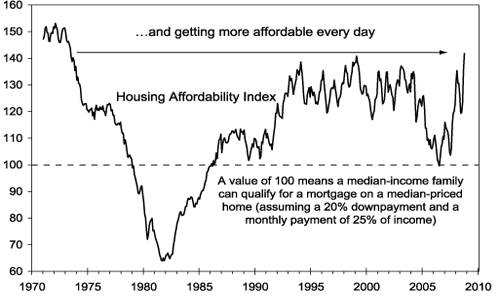You're not going to believe this... But U.S. residential real estate is now more affordable than it's been since 1973.
It's true. Thanks to 1) record low mortgage rates (Wells Fargo is offering 30-year fixed mortgages under 4.9%) and 2) a speedy fall in home prices (the median home price is down $50,000 on average nationwide)... we've arrived at "affordable" quicker than I ever imagined possible.
The Housing Affordability Index measures these two things and adds in median household income. It essentially compares the median family income to the median house payment.
|
Houses Are More Affordable Than They've Been Since 1973...
|
 |
With house prices and mortgage rates way down... poof! We're here. Houses are ridiculously affordable once again. But that alone doesn't mean it's time to buy.
"Cheap, hated, and uptrend" – that's what we look for. It's hard to find all three at any time. We have the first in U.S. residential real estate right now. Houses are cheap. We also have the second... Real estate is hated:
The latest survey of homebuilders suggests they don't expect to sell a darn thing today or in the future... The survey just hit record lows in sentiment. But you probably don't need statistics to tell you sentiment is terrible toward real estate right now. You already know it.
So real estate is cheap and hated. But what about the trend? That's the last piece of the puzzle before we'll consider buying again.
Right now, of course, the trend is still down. It's still terrible. And many facts suggest what you probably expect: We might have another year of "terrible" before we enter what could be five great years in U.S. residential real estate.
U.S. residential real estate typically bottoms right after recessions. We've seen two terrible recessions – one ended in March '75 and another ended in November '82. In those two, new home prices bottomed within two months on either side of the end of the recessions.
We also had a recession that hit real estate hard, ending in March '91. New home prices didn't bottom until a year later in that case.
After coming out of recession, new home prices typically do well for about five years. (The last official recession ended in November '01... Home prices went straight up for nearly four years after that.)
Right now, we're in recession. We could be in recession for another year. Based on history, there's no hurry to buy anything yet. Unless you're desperate, you shouldn't hurry to sell either.
If there's any good news, it's that the speed of the carnage was extraordinary. (We've seen a $50,000 fall in home prices already, and they're down roughly 25% from their highs nationwide.) Now, the factors are lining up for a legitimate bull market in real estate:
| * |
Mortgage rates nationwide will hit record lows in 2009. |
| * |
The supply of housing is at a level not seen since 1981, so prices will likely fall in 2009. But that will probably make U.S. residential real estate the most affordable it has ever been. |
| * |
Meanwhile, real estate sentiment is extremely negative. |
| * |
The government has promised to "employ all available tools" to fix it. |
| * |
Prices will bottom about when the recession ends. (A year from now? We don't know.) |
The key factor is, when will the recession end? The group that officially dates recessions won't tell us until a year after it's already over. So we need something else...
Dennis Gartman – one of my favorite newsletter writers – alerted me to the indicator with the best track record of timing the end of recessions I've ever seen. For 40 years, it has called the end of recessions with remarkable accuracy.
It sounds a bit strange... but it works. It's a ratio of the "coincident economic indicators" to the "lagging economic indicators" put out by the Conference Board. Basically, it takes common economic measures (like unemployment) and compares where we are today to where we were in the recent past. Right now, this ratio says we're in a serious recession... the worst period since 1974.
This indicator usually bottoms just about when the recession ends. We'll say that when this ratio turns up for three months in a row, we're out of recession. We're not there yet... but we'll let you know when we are.
At that point, the risks in the housing market will have turned. Based on what I've showed you today, that uptrend could be a year away... or even less.
Good investing,
Steve


